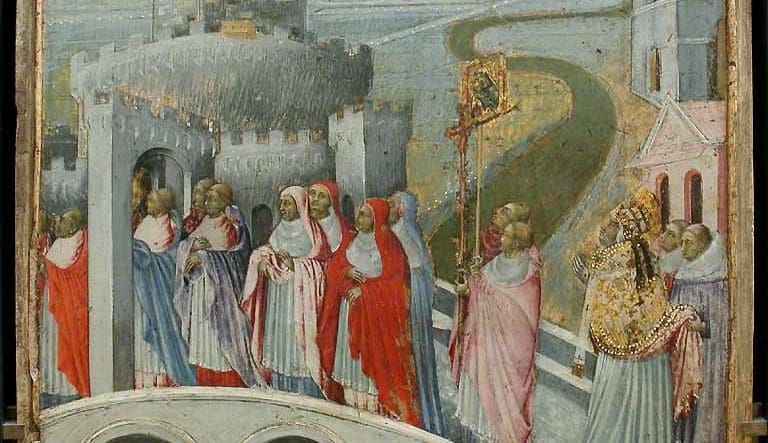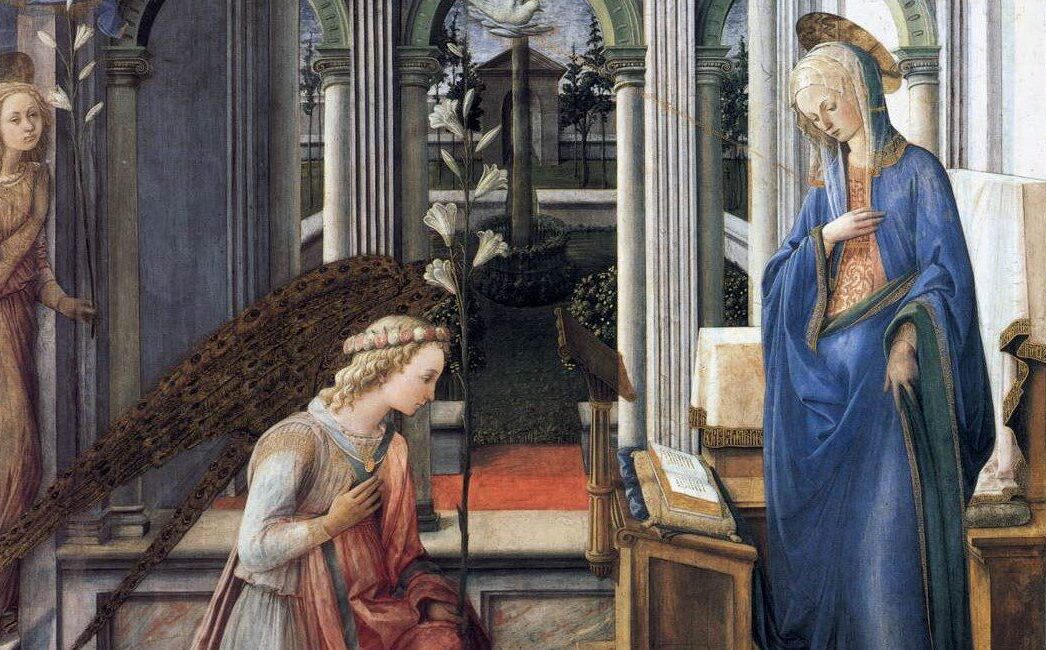In the late ancient and early medieval periods, celebrations of the Roman Mass can be distinguished into two types: the first, pontifical type is represented by the stational liturgy of the pope (or his delegate), which was held on Sundays and feast days during the liturgical year, and especially during Lent. A particular church of the city (statio) was assigned for a given day, and the pope would move in solemn procession from his residence at the Lateran palace to the stational church to celebrate Mass. This kind of processional liturgy was first created in Jerusalem around the holy sites and was adopted in Constantinople in the late fourth century. Roman stational liturgy evolved in the sixth and seventh century and became such an integral part of the rite that the statio was recorded in the Mass formulary for specific days in the temporal cycle of the Missale Romanum until the post-Vatican II liturgical reform.
The second type of celebration, the simpler form of the rite, would have been observed in the 25 titular churches within the city walls, which can be compared to parish churches. We know very little about this presbyteral liturgy, because the major sources from this time are mostly concerned with pontifical rites. In fact, the Eucharist offered by a priest (presbyter) was understood as a reduced form of the bishop’s liturgy. There is a similar pattern in the Byzantine Rite, where the original function of the two processional entrances is still intelligible in the hierarchical (i.e., pontifical) Divine Liturgy, but was obscured when the entrances were adapted to the reduced presbyteral form.[1] In its hierarchical form, the presiding bishop enters the sanctuary for the first time from his cathedra in the nave of the church at the Little Entrance. During the Great Entrance, the bishop remains in front of the altar to receive the offerings, which in the liturgy of the Great Church of Constantinople (Hagia Sophia) were prepared in a separate room, the skeuophylakion.
Ordo Romanus I
Detailed instructions for the pope’s solemn stational liturgy in Easter week are contained in the document known as Ordo Romanus I. This is in fact the oldest available ritual description of the Roman Mass, and it can be dated between the pontificate of Sergius I (r. 687-701) and the year 750, when there is evidence for its use north of the Alps. The rich and complex ritual described in Ordo Romanus I requires proficiency on the part of the liturgical actors and considerable logistical effort. Hence it is likely that a master of ceremonies produced a written record and memory aids that served to train the sacred ministers and to make the material preparations for the elaborate ceremonial.[2]
We can discern two distinct cultural forces at work in the papal stational Mass: on the one hand, the ceremonial of the imperial court and administration (Rome was still part of the Byzantine Empire at the time), and on the other hand the sacred (or hieratic) simplicity of the Roman Eucharist. Imperial ceremonial is evident especially in the procession of the pope on horseback with his court from the Lateran palace to the stational church, and in the intricate entrance rite, wherein ecclesiastical officials carried before the pope a thurible and seven candles, which were signs of honor reserved to the emperor and senior magistrates. Some of this ceremonial is attached to the proclamation of the gospel: the evangeliary is carried in solemn procession, with lights and incense, to the elevated ambo.
In an influential paper with the title “The Genius of the Roman Rite,” Edmund Bishop spoke of the “simplicity” of the Roman Mass with specific reference to the early forms of the Ordo Romanus.[3] Such a characterization of the complex ceremonial displayed in the papal stational liturgy may be surprising, even if one recalls that the comparison is not made with de-ritualized modern forms of worship, but with the historical Byzantine and non-Roman Western rites. However, Bishop rightly notes that when we come to the core of the rite—the Eucharist—the atmosphere seems remarkably different: “It may be said that with this [the proclamation of the gospel] the ceremonial parts of the old Roman mass are over, just as the sacrifice is about to begin.”[4] In particular, the Canon of the Mass is said by the pope at the altar, with few liturgical gestures: signs of the cross over the offerings are indicated in Gelasian and Gregorian sacramentaries, perhaps dating back to the middle of the seventh century; however, the elevation of the species and profound bows are added only later in the course of the Middle Ages. At the heart of the solemn papal liturgy, ritual simplicity prevails.
The Role of Chant in the Mass
Ordo Romanus I brings into relief the fundamental role of chant in the celebration of Mass. Music does not simply serve as an ornament or embellishment but has a proper liturgical function. The trained singers of the schola cantorum have a distinct ministry in the hierarchically ordered assembly: first, in the proper chants, they proclaim texts that are (with some exceptions) drawn from Sacred Scripture. This musical proclamation serves to accompany and elucidate the meaning of a specific ritual (introit, offertory, communion), and it offers a meditation on the word of God (gradual, alleluia or tract). Secondly, in the ordinary chants (Kyrie, Gloria, Sanctus-Benedictus, and Agnus Dei), the schola sings on behalf of the entire congregation and thus forms a link between the pontiff with his assistants in the sanctuary and the faithful in the body of the church.[5]
The repertory of liturgical chant sung in Rome (and the surrounding territories in central Italy) in the early medieval period is known as Old Roman chant. The codification of this plainchant “dialect” occurred considerably later than that of the Gregorian repertory, and the five complete manuscripts with musical notation that have come down to us date from the 11th to the 13th century. These manuscripts were created in a period when Gregorian chant was gaining ground in the city of Rome and eventually replaced the Old Roman tradition in the pontificate of Innocent III (r. 1198-1216).
Conclusion
Interpreting the extant sources of the papal stational liturgy present us with a fundamental problem, since they are prescriptive texts that communicate how the rite should be enacted. As historical scholarship has made us increasingly aware, we cannot simply assume that such prescriptions are identical with the way in which the liturgy was in fact carried out. Ordo Romanus I was originally designed for the solemn papal Mass in Easter week; as a template for other occasions, it was likely to be adapted to the spatial arrangements, local resources, and (quite possibly) particular observances of the stational church chosen for the day. Moreover, it is a script for liturgical actors who were, for the most part, clerics (the papal court included also lay officials). As such, Ordo Romanus I can easily give the impression of a “clericalized” liturgy, but such a view would be misleading since it abstracts from the genre and purpose of the document.
Liturgical sources from this period are not concerned with how people in general participated in the rite, let alone how they experienced it. Thus Ordo Romanus I leaves many questions that would interest us unanswered. Nonetheless, it is a historical document of the greatest significance and, with hindsight, proved to be foundational for the further development of Western liturgy.
In the next instalment, I will discuss the organization of prayers, scriptural readings, and chants in the early liturgical books.
For previous instalments of Father Lang’s Short History of the Roman Rite of Mass series, see Part I, Part II, Part III, Part IV, Part V, and Part VI.
Notes:
- See Hans-Joachim Schulz, “Liturgie, Tagzeiten und Kirchenjahr des byzantinischen Ritus,” in Handbuch der Ostkirchenkunde Bd. II, ed. Wilhelm Nyssen, Hans-Joachim Schulz and Paul Wiertz (Düsseldorf: Patmos, 1989), 30-100, at 36-37. See also Alexander Schmemann, Eucharist: Sacrament of the Kingdom, trans. Paul Kachur (Crestwood, NY: St Vladimir’s Seminary Press, 1987), 15-16. ↑
- See the critical edition by Michael Andrieu, Les Ordines Romani du haut moyen âge, 5 vol., Spicilegium Sacrum Lovaniense 11, 23, 24, 28, 29 (Louvain: Peeters, 1931-1961), vol. II, 67-108. An English version is found in John F. Romano, Liturgy and Society in Early Medieval Rome, Church, Faith and Culture in the Medieval West (Farnham: Ashgate, 2014), 229-248. For an earlier translation, published before Andrieu’s edition, see E. G. C. F. Atchley, Ordo Romanus Primus (London: Moring, 1905), 117-149. ↑
- Edmund Bishop, “The Genius of the Roman Rite,” in id., Liturgica Historica: Papers on the Liturgy and Religious Life of the Western Church (Oxford: Clarendon Press, 1918), 1-19, at 8-12. ↑
- Ibid., 10. ↑
- See Franck Quoëx, “Ritual and Sacred Chant in the Ordo Romanus Primus (Seventh–Eighth Century),” in Antiphon 22 (2018), 199–219, at 218-219. The Western chant repertory contains a number of simple melodies for the ordinary chants that could well have been sung by the people. The evidence for such simpler chants appears later than for more sophisticated pieces. This is not surprising, if one considers that most of the early extant chant manuscripts were composed for the use of the schola cantorum and for individual cantors. Chants to be sung by the assembly may have been transmitted in oral tradition, without the need for writing them down. ↑



